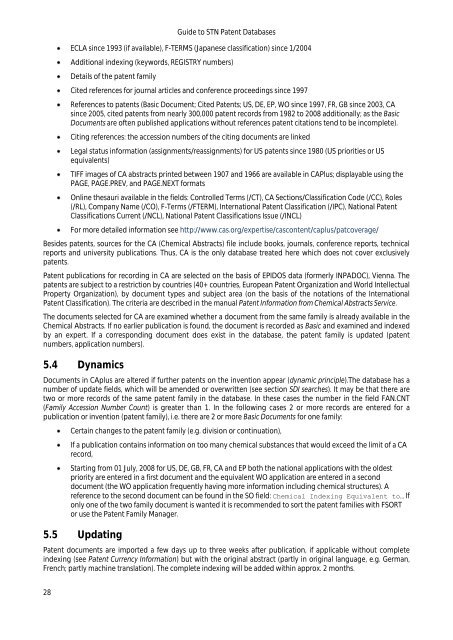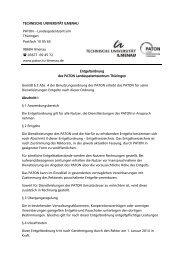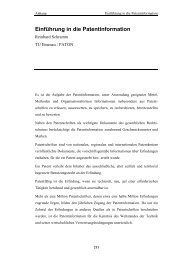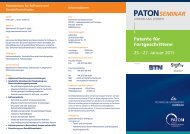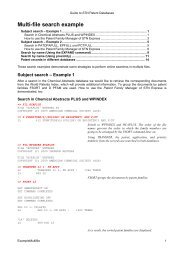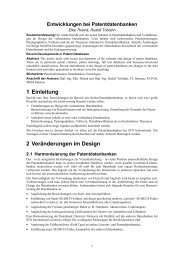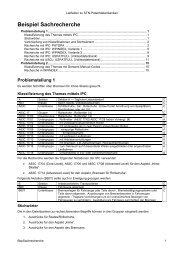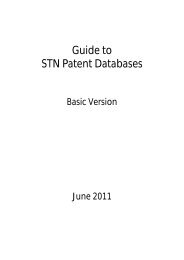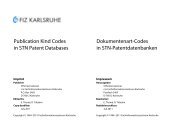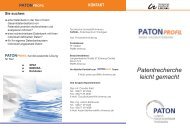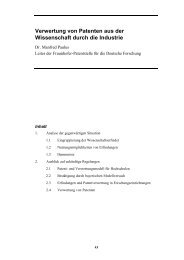Guide to STN Patent Databases – Basic Version - Paton - TU Ilmenau
Guide to STN Patent Databases – Basic Version - Paton - TU Ilmenau
Guide to STN Patent Databases – Basic Version - Paton - TU Ilmenau
Create successful ePaper yourself
Turn your PDF publications into a flip-book with our unique Google optimized e-Paper software.
28<br />
<strong>Guide</strong> <strong>to</strong> <strong>STN</strong> <strong>Patent</strong> <strong>Databases</strong><br />
ECLA since 1993 (if available), F-TERMS (Japanese classification) since 1/2004<br />
Additional indexing (keywords, REGISTRY numbers)<br />
Details of the patent family<br />
Cited references for journal articles and conference proceedings since 1997<br />
References <strong>to</strong> patents (<strong>Basic</strong> Document; Cited <strong>Patent</strong>s; US, DE, EP, WO since 1997, FR, GB since 2003, CA<br />
since 2005, cited patents from nearly 300,000 patent records from 1982 <strong>to</strong> 2008 additionally; as the <strong>Basic</strong><br />
Documents are often published applications without references patent citations tend <strong>to</strong> be incomplete).<br />
Citing references: the accession numbers of the citing documents are linked<br />
Legal status information (assignments/reassignments) for US patents since 1980 (US priorities or US<br />
equivalents)<br />
TIFF images of CA abstracts printed between 1907 and 1966 are available in CAPlus; displayable using the<br />
PAGE, PAGE.PREV, and PAGE.NEXT formats<br />
Online thesauri available in the fields: Controlled Terms (/CT), CA Sections/Classification Code (/CC), Roles<br />
(/RL), Company Name (/CO), F-Terms (/FTERM), International <strong>Patent</strong> Classification (/IPC), National <strong>Patent</strong><br />
Classifications Current (/NCL), National <strong>Patent</strong> Classifications Issue (/INCL)<br />
For more detailed information see http://www.cas.org/expertise/cascontent/caplus/patcoverage/<br />
Besides patents, sources for the CA (Chemical Abstracts) file include books, journals, conference reports, technical<br />
reports and university publications. Thus, CA is the only database treated here which does not cover exclusively<br />
patents.<br />
<strong>Patent</strong> publications for recording in CA are selected on the basis of EPIDOS data (formerly INPADOC), Vienna. The<br />
patents are subject <strong>to</strong> a restriction by countries (40+ countries, European <strong>Patent</strong> Organization and World Intellectual<br />
Property Organization), by document types and subject area (on the basis of the notations of the International<br />
<strong>Patent</strong> Classification). The criteria are described in the manual <strong>Patent</strong> Information from Chemical Abstracts Service.<br />
The documents selected for CA are examined whether a document from the same family is already available in the<br />
Chemical Abstracts. If no earlier publication is found, the document is recorded as <strong>Basic</strong> and examined and indexed<br />
by an expert. If a corresponding document does exist in the database, the patent family is updated (patent<br />
numbers, application numbers).<br />
5.4 Dynamics<br />
Documents in CAplus are altered if further patents on the invention appear (dynamic principle).The database has a<br />
number of update fields, which will be amended or overwritten (see section SDI searches). It may be that there are<br />
two or more records of the same patent family in the database. In these cases the number in the field FAN.CNT<br />
(Family Accession Number Count) is greater than 1. In the following cases 2 or more records are entered for a<br />
publication or invention (patent family), i.e. there are 2 or more <strong>Basic</strong> Documents for one family:<br />
Certain changes <strong>to</strong> the patent family (e.g. division or continuation),<br />
If a publication contains information on <strong>to</strong>o many chemical substances that would exceed the limit of a CA<br />
record,<br />
Starting from 01 July, 2008 for US, DE, GB, FR, CA and EP both the national applications with the oldest<br />
priority are entered in a first document and the equivalent WO application are entered in a second<br />
document (the WO application frequently having more information including chemical structures). A<br />
reference <strong>to</strong> the second document can be found in the SO field: Chemical Indexing Equivalent <strong>to</strong>… If<br />
only one of the two family document is wanted it is recommended <strong>to</strong> sort the patent families with FSORT<br />
or use the <strong>Patent</strong> Family Manager.<br />
5.5 Updating<br />
<strong>Patent</strong> documents are imported a few days up <strong>to</strong> three weeks after publication, if applicable without complete<br />
indexing (see <strong>Patent</strong> Currency Information) but with the original abstract (partly in original language, e.g. German,<br />
French; partly machine translation). The complete indexing will be added within approx. 2 months.


